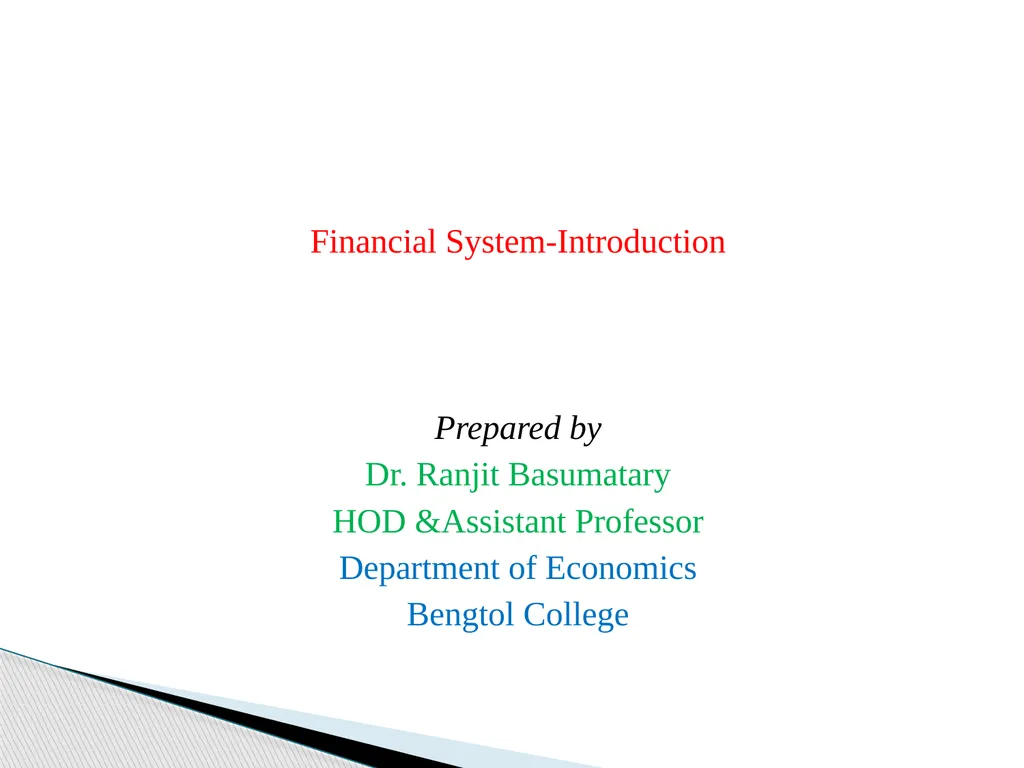Financial System-Introduction Prepared by Dr.
Author : min-jolicoeur | Published Date : 2025-05-17
Description: Financial SystemIntroduction Prepared by Dr Ranjit Basumatary HOD Assistant Professor Department of Economics Bengtol College A financial system is a complex wellintegrated set of subsystems of financial institutions markets
Presentation Embed Code
Download Presentation
Download
Presentation The PPT/PDF document
"Financial System-Introduction Prepared by Dr." is the property of its rightful owner.
Permission is granted to download and print the materials on this website for personal, non-commercial use only,
and to display it on your personal computer provided you do not modify the materials and that you retain all
copyright notices contained in the materials. By downloading content from our website, you accept the terms of
this agreement.
Transcript:Financial System-Introduction Prepared by Dr.:
Financial System-Introduction Prepared by Dr. Ranjit Basumatary HOD &Assistant Professor Department of Economics Bengtol College A financial system is a complex, well-integrated set of sub-systems of financial institutions, markets, instruments and services which facilitates the transfers and allocation of funds, efficiently and effectively. Formal and Informal Financial Systems: The financial systems of most of the developing countries are characterised by the co-existence and co-operation between the formal and informal financial sectors. This co-existence of two sectors is commonly referred to as “Financial dualism”. The formal financial sector is characterised by the presence of an organized, institutional and regulated system which caters to the financial needs of the modern spheres of economy. The informal financial sector is characterised by the presence of unorganised, non-institutional, and non-regulated system dealing with the traditional and rural spheres of the economy. FINANCIAL SYSTEM-AN INTRODUCTION The Indian financial system can also broadly classified into formal (organized) and informal (unorganised) financial system. The formal financial system comes under the purview of the Ministry of Finance (MOF), Reserve Bank of India (RBI), Securities and Exchange Board of India (SEBI), and other regulatory bodies. The informal financial system consists of: Individual money lenders such as neighbours, relatives, landlords, traders and so on. Groups of persons operating as “funds”, or “associations”. These groups function under a system of their own rules. They use names such as “fixed fund”, “association”, “saving club”, and so on. Partnership firms consisting of local brokers, pawnbrokers, and non-bank financial intermediaries such as finance, investment, and chit-fund companies. 2. THE INDIAN FINANCIAL SYSTEM (i) Financial institutions: Financial institutions are intermediaries that mobilize savings and facilitates the allocation of funds in an efficient manner. Financial institutions can be classified as- Banking and non-banking financial institutions: Banking institutions are creators of credit while non-banking financial institutions are purveyors of credit. Liabilities of the banks are part of the money supply, this may not be true of non-banking financial institutions. In India non-banking financial institutions are like HFCs, NBFCs, DFIs. Term-finance institutions like IDBI, IFCI, ICICI, SIDBI Specialised finance institutions like EXIM, TFCI, NHB, IDFC, NABARD, ICICI Venture Investment institutions in the business of mutual fund like UTI, Public Sector and Private sector Mutual Funds and insurance activity like LIC, GIC and is subsidiaries. State-level financial institutions: These are owned and managed by the state government such as SFCs, SIDCs 3. COMPONENTS OF FINANCIAL SYSTEM (ii) Financial Markets: Financial














